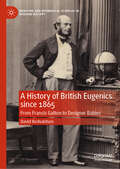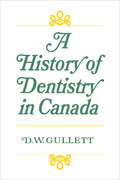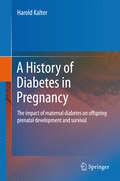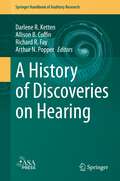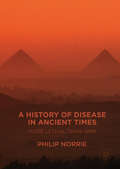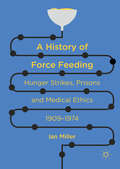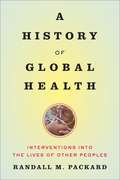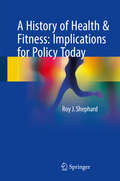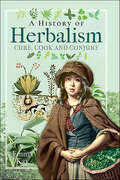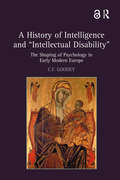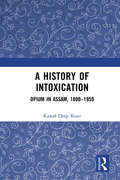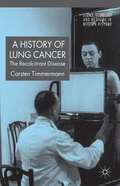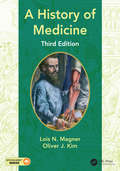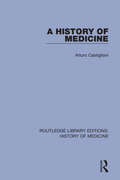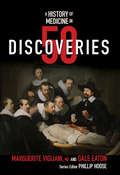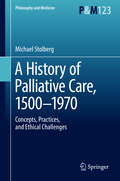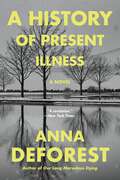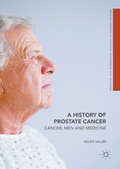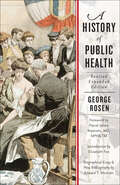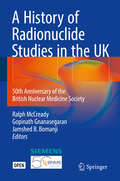- Table View
- List View
A History of British Eugenics since 1865: From Francis Galton to Designer Babies (Medicine and Biomedical Sciences in Modern History)
by David RedvaldsenThis book examines British eugenics from its origins in 1865 to the early 1990s. It considers the two institutions promoting the doctrine: the Galton Laboratory attached to the University of London; and the Eugenics Society. It charts internal and ideological changes across more than a century, seeing eugenics as primarily a political movement. The doctrine had influence on British society and guided adherents ranging from scientists to charitable ladies. The Galton Laboratory published detailed studies of heredity. It transformed itself into a centre for medical genetics after the Second World War. As early as the 1920s, the Eugenics Society was the mainspring of the doctrine, formulating what became the British version of an international ideology. It began as applied social Darwinism, later incorporating a greater degree of meritocracy and amelioration. Its support for sterilization in the 1930s eroded the kudos it had gained in policy-making circles. From the 1960s, organized eugenics was especially a forum for learned and popular discussion of biology and sociology. Medical advances after 1970 aided its continuation, notably the growth of assisted reproductive technologies. The book presents British eugenics as mostly shaped by domestic concerns, offering new revelations and interpretations with the capacity to readjust historical thinking. It also covers contemporary bioethical and political issues aligned to eugenics.
A History of Dentistry in Canada
by Donald W. GullettBeginning with the earliest records available describing the dental health of the Indians before the arrival of European settlers, Dr Gullett gives a detailed and carefully documented history of dentistry in Canada. He describes the unscrupulous tramp dentists who roamed the countryside years ago as well as their respectable contemporaries, and he traces the development of practice, education, and professional associations, as dentistry developed from an art to a science. The author spent five years gathering information for this book from public archives, libraries, personal interviews, and the records of the profession. The result is a lively and readable story told with a continuing concern for health services.
A History of Diabetes in Pregnancy: The impact of maternal diabetes on offspring prenatal development and survival
by Harold KalterType 1 diabetes is a serious and common disease, afflicting one per 200 of the population worldwide. It is widely believed to cause harmful physical maldevelopment--congenital malformations--and other consequences in the unborn children of women with the disease. This book considers the history of the disease in pregnant women and this belief that it causes anomalies since the time of the discovery of insulin in 1921, and presents a profound and critical appraisal of the subject of its supposed prenatal harmfulness.
A History of Discoveries on Hearing (Springer Handbook of Auditory Research #77)
by Arthur N. Popper Richard R. Fay Allison B. Coffin Darlene R. KettenThis volume focuses on the history of research on hearing from comparative approaches. Each chapters examines the most formative studies that led to current understanding of hearing across taxa and still influence hearing research in general. Much of the early work on hearing, which goes back to Aristotle, as well as the classic work of 16th to early 20th century scientists (e.g., Spellanzani, Retzius, Ramón y Cajal, and Helmholtz) is not well known to modern investigators. Similarly, work in the first 75 years of the 20th century is also unknown or, in some cases, dismissed because it is “old.” Much of the earlier work describes research approaches and results fundamental to our understanding of hearing as well as the beauty of observation and synthesis. The pioneering work on hearing contains ideas and questions that are still germane today. Thus, the goal of this volume is to introduce, review, and put into perspective, older but exemplary, extraordinary studies by investigators that form the basis of our knowledge as well as questions being asked today.Each chapter includes the first significant observations and approaches to hearing in the taxa and/or hearing type that is the focus of the chapter with some of the most important earlier papers discussed in some detail, including the theories, formative experiments, results, and conclusions. Each chapter provides briefer notations and citations of additional important papers that are outgrowths of the founding research – or correlate and even reverse the original works. This volume is a departure from the classic approach established for the SHAR books in which the focus has been on a single topic, and on the most recent and exciting discoveries. One difference in this volume from past SHAR volumes is that we have a more coordinated approach for the chapters to ensure that this volume is, indeed, a documentation of hearing research history, not a review of the latest status of the topic. A second difference is that the focus of the volume is on the historical value of studies. In that sense, the volume maintains the tutorial value for which SHAR books are famous, but it explores the ancestry of modern research in order to help new researchers to gain perspective on important questions and on fundamental information they may not fully appreciate – to their loss. Our interest in doing this volume comes from phenomena familiar to most senior investigators - that younger investigators often have little or no sense of the history of their discipline, and they often do not know that their “hot” new idea was not only pursued, and often solved, but further that it was solved in an elegant way. We believe it is important to bring the methodologies and discoveries on hearing done before the advent of the internet to light, for the benefit and growth of new research.In deciding on the chapter divisions for this book, we considered a number of different organizational schemes, and particularly using as a focus methodological approaches (e.g., psychoacoustics, low to high frequency types, physiology, anatomy). However, we came to the conclusion that most investigators tend to be more focused on working within a particular taxonomic group, settling on particular taxa, in many cases driven by the special hearing abilities. We also concluded that that this approach is more naturally related to the evolution not only of hearing, but also to the evolution of ideas, as much of hearing science was part of the “natural philosopher” approach that was a core element of historical discoveries.
A History of Disease in Ancient Times: More Lethal than War
by Philip NorrieThis book shows how bubonic plague and smallpox helped end the Hittite Empire, the Bronze Age in the Near East and later the Carthaginian Empire. The book will examine all the possible infectious diseases present in ancient times and show that life was a daily struggle for survival either avoiding or fighting against these infectious disease epidemics. The book will argue that infectious disease epidemics are a critical link in the chain of causation for the demise of most civilizations in the ancient world and that ancient historians should no longer ignore them, as is currently the case.
A History of Endometriosis
by Ronald BattThe early history of endometriosis is interwoven with the history of adenomyosis, since it was not until the mid nineteen-twenties that the two conditions were finally separated. A History of Endometriosis provides a detailed reconstruction of the progress made in identifying, describing and treating the condition we call today endometriosis.
A History of Force Feeding: Hunger Strikes, Prisons and Medical Ethics, 1909–1974
by Ian MillerThis book is Open Access under a CC BY license. It is the first monograph-length study of the force-feeding of hunger strikers in English, Irish and Northern Irish prisons. It examines ethical debates that arose throughout the twentieth century when governments authorised the force-feeding of imprisoned suffragettes, Irish republicans and convict prisoners. It also explores the fraught role of prison doctors called upon to perform the procedure. Since the Home Office first authorised force-feeding in 1909, a number of questions have been raised about the procedure. Is force-feeding safe? Can it kill? Are doctors who feed prisoners against their will abandoning the medical ethical norms of their profession? And do state bodies use prison doctors to help tackle political dissidence at times of political crisis?
A History of Genomics across Species, Communities and Projects (Medicine and Biomedical Sciences in Modern History)
by Miguel García-Sancho James LoweThis open access book offers a comprehensive overview of the history of genomics across three different species and four decades, from the 1980s to the recent past. It takes an inclusive approach in order to capture not only the international initiatives to map and sequence the genomes of various organisms, but also the work of smaller-scale institutions engaged in the mapping and sequencing of yeast, human and pig DNA. In doing so, the authors expand the historiographical lens of genomics from a focus on large-scale projects to other forms of organisation. They show how practices such as genome mapping, sequence assembly and annotation are as essential as DNA sequencing in the history of genomics, and argue that existing depictions of genomics are too closely associated with the Human Genome Project. Exploring the use of genomic tools by biochemists, cell biologists, and medical and agriculturally-oriented geneticists, this book portrays the history of genomics as inseparably entangled with the day-to-day practices and objectives of these communities. The authors also uncover often forgotten actors such as the European Commission, a crucial funder and forger of collaborative networks undertaking genomic projects. In examining historical trajectories across species, communities and projects, the book provides new insights on genomics, its dramatic expansion during the late twentieth-century and its developments in the twenty-first century. Offering the first extensive critical examination of the nature and historicity of reference genomes, this book demonstrates how their affordances and limitations are shaped by the involvement or absence of particular communities in their production.
A History of Global Health: Interventions into the Lives of Other Peoples
by Randall M. Packard<p>Over the past century, hundreds of billions of dollars have been invested in programs aimed at improving health on a global scale. Given the enormous scale and complexity of these lifesaving operations, why do millions of people in low-income countries continue to live without access to basic health services, sanitation, or clean water? And why are deadly diseases like Ebola able to spread so quickly among populations? <p>In A History of Global Health, Randall M. Packard argues that global-health initiatives have saved millions of lives but have had limited impact on the overall health of people living in underdeveloped areas, where health-care workers are poorly paid, infrastructure and basic supplies such as disposable gloves, syringes, and bandages are lacking, and little effort has been made to address the underlying social and economic determinants of ill health. Global-health campaigns have relied on the application of biomedical technologies―vaccines, insecticide-treated nets, vitamin A capsules―to attack specific health problems but have failed to invest in building lasting infrastructure for managing the ongoing health problems of local populations. <p>Designed to be read and taught, the book offers a critical historical view, providing historians, policy makers, researchers, program managers, and students with an essential new perspective on the formation and implementation of global-health policies and practices.</p>
A History of Global Health: Interventions into the Lives of Other Peoples
by Randall M. PackardA sweeping history explores why people living in resource-poor areas lack access to basic health care after billions of dollars have been invested in international-health assistance.Over the past century, hundreds of billions of dollars have been invested in programs aimed at improving health on a global scale. Given the enormous scale and complexity of these lifesaving operations, why do millions of people in low-income countries continue to live without access to basic health services, sanitation, or clean water? And why are deadly diseases like Ebola able to spread so quickly among populations?In A History of Global Health, Randall M. Packard argues that global-health initiatives have saved millions of lives but have had limited impact on the overall health of people living in underdeveloped areas, where health-care workers are poorly paid, infrastructure and basic supplies such as disposable gloves, syringes, and bandages are lacking, and little effort has been made to address the underlying social and economic determinants of ill health. Global-health campaigns have relied on the application of biomedical technologies—vaccines, insecticide-treated nets, vitamin A capsules—to attack specific health problems but have failed to invest in building lasting infrastructure for managing the ongoing health problems of local populations.Designed to be read and taught, the book offers a critical historical view, providing historians, policy makers, researchers, program managers, and students with an essential new perspective on the formation and implementation of global-health policies and practices.
A History of Health & Fitness: Implications for Policy Today
by Roy J. ShephardThis book provides a unique and succinct account of the history of health and fitness, responding to the growing recognition of physicians, policy makers and the general public that exercise is the most potent form of medicine available to humankind. Individual chapters present information extending from the earliest reaches of human history to the present day, arranged in the form of 30 thematic essays covering topics from the supposed idyll of the hunter-gatherer lifestyle and its posited health benefits to the evolution of health professionals and the possible contribution of the Olympic movement to health and fitness in our current society. Learning objectives are set for each topic, and although technical language is avoided as far as possible, a thorough glossary explains any specialized terms that are introduced in each chapter. The critical thinking of the reader is stimulated by a range of questions arising from the text context, and each chapter concludes with a brief discussion of some of the more important implications for public policies on health and fitness today and into the future. The material will be of particular interest to graduate and undergraduate students in public health, health promotion, health policy, kinesiology, physical education, but will be of interest also to many studying medicine, history and sociology.
A History of Herbalism: Cure, Cook and Conjure
by Emma KayFood historian Emma Kay tells the story of our centuries-old relationship with herbs. From herbalists of old to contemporary cooking, this book reveals the magical and medicinal properties of your favourite plants in colorful, compelling detail. At one time, every village in Britain had a herbalist. A History of Herbalism investigates the lives of women and men who used herbs to administer treatment and knew the benefit of each. Meet Dr Richard Shephard of Preston, who cultivated angelica on his estate in the eighteenth century for the sick and injured; or Nicholas Culpeper, a botanist who catalogued the pharmaceutical benefits of herbs for early literary society. But herbs were not only medicinal. Countless cultures and beliefs as far back as prehistoric times incorporated herbs into their practices: paganism, witchcraft, religion and even astrology. Take a walk through a medieval ‘physick’ garden, or Early Britain, and learn the ancient rituals to fend off evil powers, protect or bewitch or even attract a lover. The wake of modern medicine saw a shift away from herbal treatments, with rituals and spells shrouded with superstition as the years wore on. The author reveals how herbs became more culinary rather than medicinal including accounts of recent trends for herbal remedies as lockdown and the pandemic leads us to focus more on our health and wellbeing.
A History of Intelligence and 'Intellectual Disability': The Shaping of Psychology in Early Modern Europe
by C.F. GoodeyStarting with the hypothesis that not only human intelligence but also its antithesis 'intellectual disability' are nothing more than historical contingencies, C.F. Goodey's paradigm-shifting study traces the rich interplay between labelled human types and the radically changing characteristics attributed to them. From the twelfth-century beginnings of European social administration to the onset of formal human science disciplines in the modern era, A History of Intelligence and 'Intellectual Disability' reconstructs the socio-political and religious contexts of intellectual ability and disability, and demonstrates how these concepts became part of psychology, medicine and biology. Goodey examines a wide array of classical, late medieval and Renaissance texts, from popular guides on conduct and behavior to medical treatises and from religious and philosophical works to poetry and drama. Focusing especially on the period between the Protestant Reformation and 1700, Goodey challenges the accepted wisdom that would have us believe that 'intelligence' and 'disability' describe natural, trans-historical realities. Instead, Goodey argues for a model that views intellectual disability and indeed the intellectually disabled person as recent cultural creations. His book is destined to become a standard resource for scholars interested in the history of psychology and medicine, the social origins of human self-representation, and current ethical debates about the genetics of intelligence.
A History of Intoxication: Opium in Assam, 1800–1959
by Kawal Deep KourThis volume unearths the emerging pattern of consumption of opium in colonial Assam and the creation of drug-dependency in a social context. It analyses the competing forces of the empire which played a key role in the production and distribution of opium; national politics alongside international drug diplomacy and how these together shaped the discourse of opium in Assam; the wider implications of opium production and consumption in the agrarian economy and the narrative of the nationalist critique of intoxication. Please note: Taylor & Francis does not sell or distribute the Hardback in India, Pakistan, Nepal, Bhutan, Bangladesh and Sri Lanka.
A History of London County Lunatic Asylums & Mental Hospitals
by Ed BrandonFrom the Middle-Ages onwards, London’s notorious Bedlam lunatic hospital saw the city’s ‘mad’ locked away in dank cells, neglected and abused and without any real cure and little comfort. The unprecedented growth of the metropolis after the Industrial Revolution saw a perceived ‘epidemic’ of madness take hold, with ‘county asylums’ seen by those in power as the most humane or cost-effective way to offer the mass confinement and treatment believed necessary. The county of Middlesex – to which London once belonged – would build and open three huge county asylums from 1831, and when London became its own county in 1889 it would adopt all three and go on to build or run another eight such immense institutions. Each operated much like a self-contained town; home to thousands and often incorporating its own railway, laundries, farms, gardens, kitchens, ballroom, sports pitches, surgeries, wards, cells, chapel, mortuary, and more, in order to ensure the patients never needed to leave the asylum’s grounds. Between them, at their peak London’s eleven county asylums were home to around 25,000 patients and thousands more staff, and dominated the physical landscape as well as the public imagination from the 1830s right up to the 1990s. Several gained a legacy which lasted even beyond their closure, as their hulking, abandoned forms sat in overgrown sites around London, refusing to be forgotten and continuing to attract the attention of those with both curious and nefarious motives. Hanwell (St Bernard’s), Colney Hatch (Friern), Banstead, Cane Hill, Claybury, Bexley, Manor, Horton, St Ebba’s, Long Grove, and West Park went from being known as ‘county lunatic asylums’ to ‘mental hospitals’ and beyond. Reflecting on both the positive and negative aspects of their long and storied histories from their planning and construction to the treatments and regimes adopted at each, the lives of patients and staff through to their use during wartime, and the modernisation and changes of the 20th century, this book documents their stories from their opening up to their eventual closure, abandonment, redevelopment, or destruction.
A History of Lung Cancer
by Carsten TimmermannThe first comprehensive history of lung cancer from around 1800 to the present day; a story of doctors and patients, hopes and fears, expectations and frustrations. Where most histories of medicine focus on progress, Timmermann asks what happens when medical progress does not seem to make much difference.
A History of Medicine
by Lois N. Magner Oliver J KimDesigned for survey courses in the field A History of Medicine presents a wide-ranging overview for those seeking a solid grounding in the medical history of Western and non-Western cultures. Invaluable to instructors promoting the history of medicine in pre-professional training, and stressing major themes in the history of medicine, this third edition continues to stimulate further exploration of the events, methodologies, and theories that have shaped medical practices in decades past and continue to do so today.
A History of Medicine (Routledge Library Editions: History of Medicine #2)
by Arturo CastiglioniOriginally published in 1941, A History of Medicine provides a detailed and comprehensive guide to the advancement of medicine, from Ancient Egypt, and Ancient Babylonia, all the way up to the 20th century. The book looks at the close relationship between the progress of medicine and its advancement of civilization, it covers the development of medicine from, old magical rites, religious creeds, classical Hippocratism and revolutionary discoveries, while looking at the associated economic, intellectual, and political conditions of life in different nations, during different times. The book provides an essential and detailed look at the rich history of medicine and how it has impacted society.
A History of Medicine in 50 Discoveries (History in 50 #0)
by Phillip Hoose Gale Eaton Marguerite ViglianiVigliani and Eaton’s high-interest exploration of medicine begins in prehistory. The 5,000-year-old Iceman discovered frozen in the Alps may have treated his gallstones, Lyme disease, and hardening of the arteries with the 61 tattoos that covered his body—most of which matched acupuncture points—and the walnut-sized pieces of fungus he carried on his belt. The herbal medicines chamomile and yarrow have been found on 50,000-year-old teeth, and neatly bored holes in prehistoric skulls show that Neolithic surgeons relieved pressure on the brain (or attempted to release evil spirits) at least 10,000 years ago. From Mesopotamian pharmaceuticals and Ancient Greek sleep therapy through midwifery, amputation, bloodletting, Renaissance anatomy, bubonic plague, and cholera to the discovery of germs, X-rays, DNA-based treatments and modern prosthetics, the history of medicine is a wild ride through the history of humankind.
A History of Palliative Care, 1500-1970: Concepts, Practices, and Ethical challenges (Philosophy and Medicine #123)
by Michael StolbergThis book on the history of palliative care, 1500-1970 traces the historical roots of modern palliative care in Europe to the rise of the hospice movement in the 1960s. The author discusses largely forgotten premodern concepts like cura palliativa and euthanasia medica and describes, how patients and physicians experienced and dealt with terminal illness. He traces the origins of hospitals for incurable and dying patients and follows the long history of ethical debates on issues like truth-telling and the intentional shortening of the dying patients' lives and the controversies they sparked between physicians and patients. An eye opener for anyone interested in the history of ethical decision making regarding terminal care of critically ill patients.
A History of Plague in Java, 1911–1942
by Maurits Bastiaan MeerwijkIn A History of Plague in Java, 1911–1942, Maurits Bastiaan Meerwijk demonstrates how the official response to the 1911 outbreak of plague in Malang led to one of the most invasive health interventions in Dutch colonial Indonesia. Eager to combat disease, Dutch physicians and officials integrated the traditional Javanese house into the "rat-flea-man" theory of transmission. Hollow bamboo frames and thatched roofs offered hiding spaces for rats, suggesting a material link between rat plague and human plague. Over the next thirty years, 1.6 million houses were renovated or rebuilt, millions more were subjected to periodic inspection, and countless Javanese were exposed to health messaging seeking to "rat-proof" their beliefs along with their houses.The transformation of houses, villages, and people was documented in hundreds of photographs and broadcast to overseas audiences as evidence of the "ethical" nature of colonial rule, proving so effective as propaganda that the rebuilding continued even as better alternatives, such as inoculation, became available. By systematically reshaping the built environment, the Dutch plague response dramatically expanded colonial oversight and influence in rural Java.
A History of Present Illness: A Novel
by Anna DeForestThis &“brutal and brave&” (Booklist) novel transmutes the practice of medicine into a larger exploration of humanity, the meaning of care, and the nature of annihilation—physical, spiritual, or both. A young woman puts on a white coat for her first day as a student doctor. So begins this powerful debut, which follows our unnamed narrator through cadaver dissection, surgical rotation, difficult births, sudden deaths, and a budding relationship with a seminarian. In the troubled world of the hospital, where the language of blood tests and organ systems so often hides the heart of the matter, she works her way from one bed to another, from a man dying of substance use and tuberculosis, to a child in pain crisis, to a young woman, fading from confusion to aphasia to death. The long hours and heartrending work begin to blur the lines between her new life as a physician and the lifelong traumas she has fled. In brilliant, wry, and biting prose, A History of Present Illness is a boldly honest meditation on the body, the hope of healing in the face of total loss, and what it means to be alive. 2023 Rosenthal Family Foundation Award, American Academy of Arts and Letters • A Lit Hub Most Anticipated Book of 2022 • A Publishers Weekly &“Writer to Watch&” &“A revelation.&” –The New York Times
A History of Prostate Cancer: Cancer, Men and Medicine (Medicine and Biomedical Sciences in Modern History)
by Helen ValierThis book offers a comprehensive and inclusive insight into the history of prostate cancer and its sufferers. Until recently, little practical help could be offered for men afflicted with the devastating diseases of the genitourinary organs. This is despite complaints of painful urination from aging men being found in ancient medical manuscripts, despite the anatomical discoveries of the European Renaissance and despite the experimental surgical researches of the eighteen and nineteenth centuries. As diseases of the prostate, including prostate cancer, came to be better understood in the early twentieth century, therapeutic nihilism continued as curative radical surgeries and radiotherapy failed. The therapeutic 'turn' came with hormonal therapies, itself a product of the explosive growth of U. S. biomedicine from the 1940s onwards. By the 1990s, prostate cancer screening had become a somewhat ubiquitous but controversial feature of the medical encounter for American men as they aged, which greatly influenced the treatment pathways and identity of the male patient: as victim, as hero, and ultimately, as consumer.
A History of Public Health
by George RosenGeorge Rosen's wide-ranging account of public health's long and fascinating history is an indispensable classic.Since publication in 1958, George Rosen's classic book has been regarded as the essential international history of public health. Describing the development of public health in classical Greece, imperial Rome, England, Europe, the United States, and elsewhere, Rosen illuminates the lives and contributions of the field's great figures. He considers such community health problems as infectious disease, water supply and sewage disposal, maternal and child health, nutrition, and occupational disease and injury. And he assesses the public health landscape of health education, public health administration, epidemiological theory, communicable disease control, medical care, statistics, public policy, and medical geography.Rosen, writing in the 1950s, may have had good reason to believe that infectious diseases would soon be conquered. But as Dr. Pascal James Imperato writes in the new foreword to this edition, infectious disease remains a grave threat. Globalization, antibiotic resistance, and the emergence of new pathogens and the reemergence of old ones, have returned public health efforts to the basics: preventing and controlling chronic and communicable diseases and shoring up public health infrastructures that provide potable water, sewage disposal, sanitary environments, and safe food and drug supplies to populations around the globe.A revised introduction by Elizabeth Fee frames the book within the context of the historiography of public health past, present, and future, and an updated bibliography by Edward T. Morman includes significant books on public health history published between 1958 and 2014. For seasoned professionals as well as students, A History of Public Health is visionary and essential reading.
A History of Radionuclide Studies in the UK: 50th Anniversary of the British Nuclear Medicine Society
by Gopinath Gnanasegaran Ralph Mccready Jamshed B. BomanjiThe British Nuclear Medicine Societycelebrates its 50th Anniversary with this booklet, which reflectsthe research of many of the pioneers in the use of radionuclides for thediagnosis and therapy of human disease. Since 1949 there have been remarkable advancesin radionuclide techniques and imaging equipment: from the first devices "home-made"in the many physics departments throughout the UK, to the sophisticatedmultimodality imagers now in everyday use in Nuclear Medicine. The BNMS hasbeen instrumental in promoting the use of radionuclide techniques in theinvestigation of pathology by supporting and providing education, research andguidelines on the optimum use of radiation to help patients. The future ofNuclear Medicine is bright, thanks to improved imaging resolution, newradiopharmaceuticals, and new diagnostic and therapeutic techniques andprocedures.
